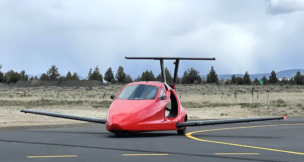Up Close with Michael Crow
Arizona Capitol Reports Staff//January 9, 2009//[read_meter]
Michael Crow left New York and his executive vice provost position with Columbia University in 2002 to become the 16th president of Arizona State University, bringing with him a strong research background in science and technology innovation.
As president, Crow has sought to strengthen ASU’s reputation as a research institute, a goal not without criticism from state lawmakers. And looking forward to the 2009 legislative session, Crow knows there will be many more issues upon which he and some key legislators will not agree.
Cuts to the university’s fiscal 2009 budget and the anticipation of greater cuts in the future by legislators hoping to resolve the state’s projected $3 billion deficit has led Crow to criticize the Legislature’s approach to managing the state’s economy. Crow hopes to convince the incoming Republican-controlled Legislature and Governor’s Office of the importance of investing in what he calls the state’s knowledge infrastructure.
But the university president acknowledges the state’s fiscal realities will likely force him and his staff to find ways to make more cuts to an already-unraveled budget while still upholding the responsibilities he believes the university has to its students and the community.
What is your birth date?
Oct. 11, 1955.
Where were you born?
San Diego, California.
What sports did you play in high school or college?
I wrestled heavyweight in high school, I played varsity football – nose guard and center – and I threw the discus and shot put. In college – Iowa State – I was a javelin thrower for four years.
What was the last book you read?
"Outliers" by Malcom Gladwell and "American Creation" by Joel Ellis.
When you were a kid, what were your career ambitions?
Weatherman until the 4th grade, then an ocean explorer until the 9th grade, then some kind of science guy.
What was your favorite Halloween costume as a child?
A "Lost in Space" robot.
What was your favorite moment of 2008?
Watching the unequaled American democratic system at work.
What is your favorite statistic?
SAT scores are best predicted by zip codes. Therefore, they don't tell us anything about ambition, intelligence or creativity.
Last year's State of the State address largely focused on education. What do you expect out of this year's address?
I think the out-going governor will highlight her achievements more than anything. I think she has set her sights on Washington now. I think Governor Napolitano has set the stage for Arizona to advance its education infrastructure, what I call its knowledge infrastructure. Our knowledge infrastructure has advanced the last few years, but we are still not to the point where we are as competitive as we ought to be to make our economy more robust. Our knowledge infrastructure investments are absolutely critical, public and private. It is not just about public investments. It is about families investing, it is about the state investing, it's about community investing and it's about private companies investing. We are in a build-up mode, where we are expanding our knowledge infrastructure. If we do it right, we will enhance our competitiveness. If we do it wrong, we will be blown out of the water. The world is changing so fast. They dynamics of the American economy are changing so rapidly. If we can advance the most educated work force and the most educated citizens as rapidly as possible, our competitiveness will be increased dramatically.
Are you worried the incoming Governor Jan Brewer will support policies that stop this advancement?
I don't know what the incoming governor's positions will be. I have only had one conversation with her, but she was positive in the conversation. What I am hopeful for, is that the incoming governor will understand that … you have to encourage private investment and make public investment, and a lack of those two things together will limit our knowledge infrastructure and put Arizona into a position where our recovery will be delayed and our recovery, when it does happen, will be limited. The American economy has shifted. We cannot any longer operate under the assumption that somehow we are in a position where we can just rely on consumerism, and furniture sales and construction works. Hopefully everybody understands that now. What we need is a robust and diverse economy. The way you get a robust and diverse economy is a whole range of factors: low taxes, high education performance, business friendly rules and regulations. If one just comes in and approaches the present fiscal condition of the state from a cut-only angle, that is irresponsible.
Have you worked with Brewer at all in the past?
No. I have talked to the leaders of the transition team. I have talked to the education policy leaders. I have also spent time talking to the incoming Senate president and incoming speaker of the House and the governor-designate. And what I would say among all of them is that there isn't yet a consensus about the importance of preparing for the future. There is so much attention being placed on the sort of day-to-day operations of the budget. I understand that needs attention. We have to manage that at the university also. But now is the time to think through what investments we are going to make to prepare ourselves for the future. I don't think that logic is yet there.
The universities escaped a special legislative session but –
We would have preferred a special session so that decisions would have been made faster. One of the things that would be helpful is people recognizing that every week that passes, we are delivering a service. The state already purchased from us, in a sense, the service we are delivering. We have record enrollment. We will have record enrollment beyond anything we have ever seen in a spring semester in the history of the university. That is we will have the largest transition from the fall semester to the spring semester in the history of the institution. We have thousands more students than we had last year. We have reduced investment from the state. We are in a very challenging situation where we are being asked to deliver a higher quality product, a higher quality service with fewer and fewer recourses along the way. In business, if someone doesn't purchase your services, you don't have to deliver it. They can only acquire the service when they pay for it. We have to deliver the service even when our investment partners, the state, renege on their previously allocated dollars. We are in a very difficult situation.
We are anticipating additional cuts. The 2009 budget has been cut once and it will be cut at least once more. We understand the fiscal realities of the state. The advancement in terms of managing the state's budget from a cost-reduction perspective only is irresponsible. There is no other word for it other than irresponsible. If one wants to make certain that we have no opportunities at the end of the cutting process, then we should cut all of our investment opportunities. Some things the state invests in are investments that actually generate a return. Some things the state invests in are expenses, they are just merely expenses. Universities and education in general are investments that generate a measurable, specific, positive return. One has to calcula
te all of that in anything one does.
The cuts from the 2009 budget forced the universities to remove inefficient expenditures. What is there left to cut?
We approached the present situation with as entrepreneurial spirit as we possibly can. First, if you don't have entrepreneurial universities, they won't be adaptive. We are down to a point now where less than 30 percent of our operating budget comes from the state. The rest we generate from tuition, from research, from enterprises, from gifts, from foundation relationships that we have, from partnerships, from all that kind of stuff. Our first approach to any investment shortfall is to seek additional revenue. Well you generate more revenue by retaining your students, launching special programs – so for instance, our winter session this year had an over 100 percent revenue increase. Now those are not big numbers in terms of billions. They are in the low millions, but you pursue revenue.
The second thing that we do is restructure the institution. We have combined 19 departments and lowered the administrative costs dramatically. We have eliminated the administrative structures from two colleges and will very likely eliminate the administrative structures for two more colleges.
Which colleges were those?
Well, we eliminated the school of Global Management and Leadership on the West Campus, and we have eliminated the School of Human Services on the West Campus. The administration for these schools has been eliminated, not the actual programs and classes. We will save from that because we are reducing our administrative costs by becoming as efficient as possible.
The third thing we do is we make cuts. We eliminated 250 faculty associates for the spring semester. We have laid-off or kept vacant 600 positions up to this point. Those are dramatic changes for us, particularly because we have increased demand for our services. The freshman class that came to our university this year was of the highest quality ever and the most diverse ever. Demand for what we are offering is at unbelievable levels. The services that we are offering at the university are very popular right now.
So where do you have left to cut as the Legislature makes more budget cuts?
This is what is going to be difficult. As the cuts grow deeper and less well planned – so we are now more than 50 percent through the fiscal year. The faculty is already hired. The programs are already in place. We are ready to go. Everybody is hired, classes are prepared, syllabi are prepared, research labs are prepared and everything is under way. And now the Legislature wants to come in and say "well listen, we don't really think we are going to have the money we thought we were going to have and we are going to need the money back." At some point we are going to have to have additional lay-offs of personnel, dramatic lay-offs. Ultimately, depending on the size of the cuts, we will have to look at the financial aid provided to our students, because we self finance that through the university, not through the state's resources. We have thousands and thousands of students who have earned merit-based financial aid – they worked really hard in high school – but we may not be able to afford that. There will be some members of the Legislature that say "so what, we shouldn't be providing them financial aid anyway." Well we are not giving them financial aid from state resources; we are giving them financial aid from university resources.
And we are going to have to look at possible program elimination.
It is the magnitude and the order of these reductions, matched with the fact that the state has not allowed the university to be as entrepreneurial as it could be that causes the most problems. I visited a very entrepreneurial university a few weeks ago – Penn State, which has a modest state investment and a large tuition investment. The state sort of wants their cake and to eat it too. They want to invest less in the university, and they want tuition to be low. The outcome of that is a less than grade-A university.
ASU did receive what you requested in tuition increases for the 2009-10 academic year. What help will that tuition increase offer?
It helps some. Just to put it into perspective, the budget cuts that we already implemented are greater than the entire revenue increase from tuition, not including any future reductions in the state's investment.
During the Board of Regents meeting one of the regents suggested raising tuition by only 3.7 percent. When that was being debated, were you just biting your nails hoping it wouldn't pass?
From my perspective, the low tuition arguments are a red herring. There are fantastically accessible universities in the United States with tuition dramatically above ours. Our accessibility has gone up dramatically as our tuition has increased. That is because we have the resources through the way we structure ourselves financially to maintain access.
President Bush signed into law the expansion of the Pell Grant, which will give families greater access to financial aid. In addition, President-elect Obama said he supports those expansions of the Pell Grant, and he is going to be giving tax breaks of $4,000 to families for their children to go on to the university. That is fantastic. And so we are already a modestly-cost university and we don't have to be a zero-cost university because there is financial aid for students who can't pay. Students that can pay, should.
The Board of Regents also raised the minimum amount of university funds required to be set aside for need-based financial aid from 16 percent to 17 percent. What difference, if any, can that 1 percent really make?
Well what that means is that we are maintaining our commitment to financial aid since Arizona is one of the few states that does not provide state-based financial aid. The sad thing about this, and I said this to Representative Adams and Bob Rob at ~The Arizona Republic~ – he is often criticizing us for being a monopoly, saying ASU keeps all the private colleges away. I told him we don't keep the private colleges away. The state has structured itself to be one of the most unfriendly environments to the emergence of private colleges in the whole country. One, there is no state-based financial aid. No private college can make it on a tuition that is below a certain level and you need state- based financial aid. In Pennsylvania, most of the state-based financial aid goes to private colleges. I support that. The other thing that happens is that our tuition is too low and our quality is too high. That means, why would someone pay $15,000 to go to local college X to get an education that is not at the level that they could pay $5,000 to get going to the local state university, ASU?
You said the students this year were the highest quality ever. ASU has historically been viewed as a school anyone can get into, a sort of party school. Is there truth to that?
That is false. Unfortunately that is a legend that creates a distortion in reality. Sixty-eight percent of the students who graduate from high school in Arizona can't even apply to the university. They don't qualify. They didn't take the right courses in high school, and they didn't graduate in the top 25 percent of their class. Automatic admission into ASU is graduating in the top 25 percent of your class and completion of 16 specified courses with better than a C grade.
The party-school image is a joke. It is worse than a joke. We are so far past that. University of Wisconsin at Madison has had drunken student riots involving thousands of students, but we have never had anything like that. They have had that at Iowa State, they have had that at Michigan State, but we have never had anything like that at all. We don't have the
issues and problems that other schools of our size have. As those kinds of things go, we are among the most well behaved, most behaviorally conservative large universities in the country. That is a misnomer that comes from people seeing palm trees in January and guys playing Frisbee with no shirt on in March, and they say "those guys must just be goof offs."
I came here from Columbia University where I was a faculty member. I teach every year – I make every administrator teach. The students I have here are very good students. People don't understand that so many students get in because they know the qualification for application. If you are doing well in Arizona and you have taken all the classes and you apply, the chances you are going to get in are very high.
But it is true that a majority of ASU's students graduate with a BA in six years instead of four, correct?
Any college or any university that has students going to it that actually have jobs while they are going, the four-year graduation is a fantasy.
So you don't see this as a failure on the part of the university?
Well, no. At Columbia, 96 percent of the students graduate in four years. The percentage of students who work off campus – zero, almost zero. A lot of students might work on campus in jobs integrated into their curriculum. And for places like that, if you come from a family that cannot afford to go to Columbia, you get large amounts of financial aid. Here you get little amounts of financial aid, so we have large numbers of students who are working.
Now, are we happy about our graduation or retention rate? No. It turns out that our retention rate from freshman to sophomore year is about ten points below what we would like it to be. It is up dramatically. We made the largest increase in the history of the university last year in retention. Our graduation rate is about 10 points below where we would like to see it.
What is the university doing to raise graduation and retention rates?
Well, it turns out there is a correlation with resources. When you are dealing with a culturally diverse population of students like we are, where they are not hand selected like they are at Princeton – so every student at Princeton is hand picked for the class. Well, ours isn't that. Ours are hardworking high school students coming largely from middle class and working class families. To help them to be successful you need advisers, small class sizes, you need a whole bunch of things. Some of those things we can provide. Some of those things are harder to provide.
I ask students all of the time when we are debating tuition whether they want our faculty to be good. They all say, "Yes, we want a good faculty." Do you want our faculty to be as good as the faculty at USC, at Stanford? "Yes." Well it turns out we all recruit from the same pool. A Stanford student pays $36,000 in tuition. A student here coming in pays less than $6,000. Stanford has $30,000 more just in tuition. Some students will say the state makes up that difference. No, the state gives us $7,000 per student. So, how are we even in the game? It is only because we are really smart about how we can run this institution. We don't build fancy things. We don't do fancy things. We hire a great faculty, we just don't hire as many as we need. That then affects our retention rate and our graduation rate.
Due to the importance of advisers to retention and graduation, are those positions kept off the table when the university considers areas to reduce spending in response to legislative budget cuts?
Those are the groups exempted from budget cuts. At some point they can be, but right now regular faculty is not on the table. Academic advisers are not on the table. Student success officers are not on the table. Those are the three categories of employment we have kept off the table.
Turning to the types of programs offered at ASU, the university has spent a lot of time and money building up the Downtown, West and Polytechnic campuses in recent years. What types of benefits do these satellite campuses offer that warrants the additional administrative and building costs?
Arizona now is larger than Missouri or Massachusetts in population. Maricopa County has almost as many people as the state of Colorado. And Colorado has 15 percent higher percentage of its population college educated than Arizona. They have more students in college than Arizona has in college. Our factory is too small. We are under-producing college graduates by about 30,000 per year from what it would take to get to the natural average. The way to get to your question, then, is kind of interesting. This is when the arguments get kind of strange because people ask "how do we cut back?" We are not even producing to the national average yet. We are under-producing college graduates, and for every percentage point of college graduates we don't have in the economy is $3 billion a year less economic activity. You can see that adds up quickly. If we are going to be more competitive with more college graduates, then how are we going to get them? Well, you can expand your public universities a little bit, try to attract a private university, hope that your for-profit private universities such as Phoenix College or Western International can get going. You need all of those things. Some people would say, "Well just recruit them all." You can't recruit that many, and even if you could, what about the people who live here. I guess they will not have access to the higher level jobs and their children will not have access to the higher paying jobs because their public university factory is too small.
We are 30,000 college graduates a year below what it takes to get to the national average. Guess how many students we are graduating now – 30,000. We are 100 percent below production. I don't know that this is well grasped yet. I don't know that it is understood. Just go back and look at the number of public high schools added in the last eight years. It is several dozen. What about new seats in the universities? At ASU you have a lot of new seats because we convinced the people of Phoenix to build a campus in downtown. We expanded the Polytechnic campus and moved that forward. We have more seats because we have grown the institution. All these new students have to go somewhere. That is what we are trying to do.
You have also worked to develop a lot of partnerships with other universities in and out of the state. Why?
When a student comes here from any family, any background and any income level they have a very broad set of opportunities. We sometimes refer to ourselves as a dream machine. You show up here and you are thinking about dance, you are thinking about music, you are thinking about becoming a painter, so as a public university we have to be comprehensive. And to be comprehensive we can't actually do everything. That is why we build partnerships with other universities to help us to do that. Some students want to go abroad. Some students want to spend time in New York, so we will build a partnership with a school in New York. Some students want to be inventors. Well, that means we should work with other universities where our research inventions and their inventions might have a net enhancement. We are constantly looking for ways to keep this university as one of the pulsing network nodes. This is a huge center of intellectual creativity. There are people coming from all over the world. We have visitors from everywhere. We have students visiting, we have faculty visiting, we have speakers, we have inventors, we have activists and we have everything that you can imagine. That is the way that we work. We create this environment of maximum creativity and maximum learning. You do that by building alliances and relationships and connections.
We a
lso think our partnerships benefit the city, meaning the greater Phoenix area. Let me give you an example. Because we are connected, when the wave of green energy technologies move forward, Phoenix will have several cards on the table to perhaps get into this game. And let me tell you, if we don't get in on this wave, from an economic perspective, it is a huge loss for us. It will set us back decades. One of the cards on the table about the level of a jack – meaning we are not at the level that we wish we could be but we are still a face card – is ASU. We have 15 or 20 portfolio technologies in algae-based energy systems, hydrogen-based energy systems, solar photovoltaic systems and new micro-sized batteries, thin film computers that take the sunlight and generate their own energy. Six years ago we didn't have any of this stuff. Now we are in the game. Every one of those entities is connected to several or a dozen other enterprises. The way the game works these days is where is the leading edge of innovation, what is the network that's driving that forward and who's connected to it? If this university is not connected to it, it is virtually worthless. It is of no value. It is nothing but a glorified high school. \
But is what you're talking about really the responsibility of a public university?
This is one of the things that people don't understand about what universities have become. Our core mission is teaching. The second part of our responsibility is to create a learning environment across 350 subjects. Then we have a responsibility as discoverers. We also have 10,000 people here every day involved in the discovery of something new. This is of tremendous value to our students and the community. We are trying to design an institution that is, in a sense, an outstanding example of what a high-end, knowledge enterprise is all about. What do we produce? We produce people, we produce ideas and we produce some of the coolest stuff in the world. ~Wired~ magazine just announced today that one of the ten great inventions of 2008 is from ASU.
What was the invention?
It is our thin film technology that our lab is developing. It is a wearable computer. Computers that are no thicker than a piece of paper that can be just thrown away. That is a fantastic invention. Of all the great inventions of the world, I think it was ~Time~ or ~Newsweek~, that picked our algae jet fuel. We have some people out on the Polytechnic campus that engineered a bug that produces kerosene jet fuel without cracking. It is teaching, learning and discovery.
Another thing we try to be is of maximum service to the community. It is funny that we get ripped for having "easy" admissions standards; well, we would have it no other way. Most of these admissions standards that are held up by the great elite colleges are a crock. They are just ways to keep kids out. They are just ways to proffer this kind of elitism. That is not who we are. No public university in the country should be on that path. If they are, they have abandoned, in our view, their public mission. We will not abandon our public mission, we just won't.












